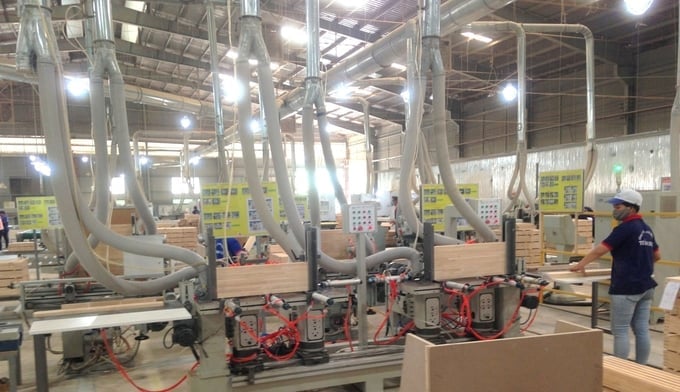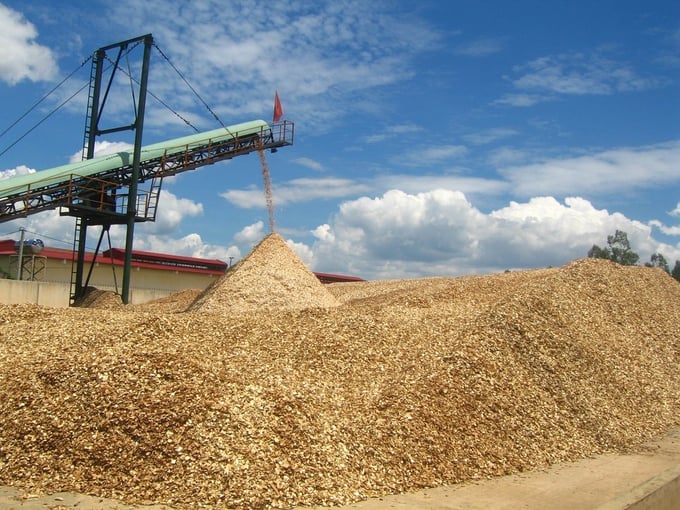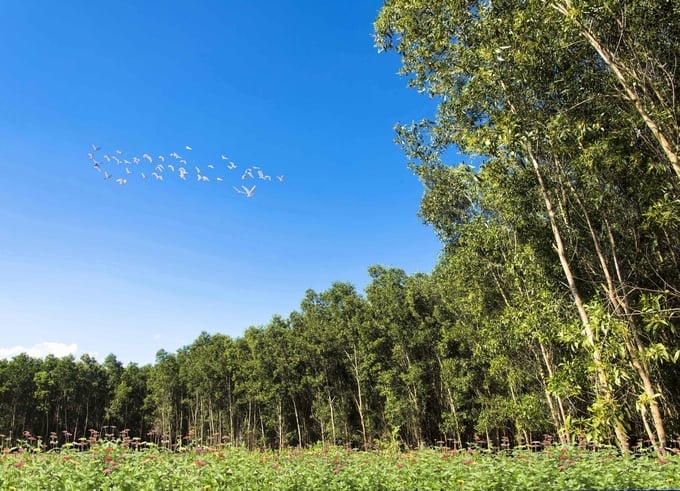June 21, 2025 | 01:37 GMT +7
June 21, 2025 | 01:37 GMT +7
Hotline: 0913.378.918
June 21, 2025 | 01:37 GMT +7
Hotline: 0913.378.918
During the wood processing and export industry handover conference for the first quarter of 2024 held on March 9 in Binh Dinh province, the Department of Forestry announced that the export turnover of wood and forestry products in 2023 experienced a considerable decrease of 15.4%. Namely, the EU market experienced the largest decline of 38.2% compared to 2022, followed by South Korea at 18.8%, the United States at 14.67%, China at 14.5%, and Japan at 7.5% decrease.
This significiant decline has been attributed to an inflation rate over 8% in several major wood importing markets of Vietnam such as the EU and the United States. Consequently, these countries implemented various tight monetary policies, thereby restricting consumers' spending capacity, with a noticeable impact on non-essential items, including wood products. Additionally, logistic costs, prices of raw wood materials, and input materials have increased as a result of conflicts in Eastern European countries. Notably, the price of wood chips decreased from 195 USD per ton in 2022 to 135 USD per ton in 2023; the price of wood pellets decreased from 180 USD per ton in 2022 to 100 USD per ton in 2023.

Deputy Minister of Agriculture and Rural Development Nguyen Quoc Tri delivering a speech at the wood processing and export industry handover conference for the first quarter of 2024. Photo: V.D.T.
According to the Department of Foresty, the Vietnam's wood industry will continue to face increasing difficulties and challenges due to ongoing conflicts in Eastern Europe. Consequently, logistic costs, prices of raw wood materials, and input materials are expected to remain at a high level. The risk of trade fraud, false origin declarations of products, and increasingly complex trade competition are also on the rise. On the other hand, several key markets of the Vietnam's wood industry are demanding stricter control over the legality of wood sources, with the aim of preventing deforestation and promoting green production to reduce greenhouse gas emissions.
However, the global furniture market possesses significant potential, with an annual value of approximately 405 billion USD, and an annual wood and wood product import turnover of approximately 230 billion USD. To date, Vietnam's wood and wood product exports represent only 6% of the global market share, providing Vietnamese wood businesses with ample opportunities to develop in the near future.

Mr. Do Xuan Lap, Chairman of Vifores, acknowledges the challenges that the wood industry must tackle in 2024. Photo: V.D.T.
Furthermore, Vietnam has ratified and effectively utilized various free trade agreements including the Comprehensive and Progressive Agreement for Trans-Pacific Partnership (CPTPP), Vietnam - EU Free Trade Agreement, Vietnam - ASEAN Free Trade Agreement, Vietnam - Japan Free Trade Agreement, Vietnam - Chile Free Trade Agreement, Vietnam - South Korea Free Trade Agreement, Vietnam - China Free Trade Agreement, Vietnam - Thailand Free Trade Agreement, Partnership Agreement between Vietnam and the EU on Forest Law Enforcement, Governance, and Trade (FLEGT), and the agreement between the Government of Vietnam and the United States on the exploitation and trade of illegal timber. These agreements present Vietnamese wood businesses with favorable opportunities to continue expanding strongly into the global market.
Additionally, domestic timber resources are being harvested from over 3.93 million hectares of planted forests, capable of supplying over 30 million cubic meters of wood annually for processing and exporting wood products. Namely, the domestic market with a population of nearly 100 million people provides competitive advantages for the continued development of Vietnam's wood processing industry.

The export turnover of Vietnamese wood and forest products reached approximately 2.68 billion USD in the first two months of 2024, which is an increase of 47% compared to that of the same period in 2023. Photo: V.D.T.
"The Vietnam's wood industry aims to achieve a total export turnover of 15.2 billion USD for wood and forest products in 2024, with wood and wood products accounting for over 14.2 billion USD, representing an increase of approximately 6% compared to that of 2023. The export turnover of Vietnamese wood and forest products reached approximately 2.68 billion USD in the first two months of 2024, which is an increase of 47% compared to that of the same period in 2023." said Mr. Tran Quang Bao, Director of the Forestry Department.
Mr. Do Xuan Lap, Chairman of Vifores, acknowledges the challenges that the wood industry must tackle in 2024. In addition to heightened regulations on the origin of raw wood materials, the United States' trade protection policies are undergoing revisions, with a total of 22 amendments related to anti-dumping and countervailing duty investigations, including the introduction of new subsidy determination measures such as export insurance, debt write-offs, and direct taxes, which pose as considerable obstacles for domestic wood businesses.

The price of wood chips decreased from 195 USD per ton in 2022 to 135 USD per ton in 2023. Photo: V.D.T.
The impact of greenhouse gases with regards to trade policies, as outlined in a bill requested by U.S. legislators, requires the country to conduct studies on emission intensity for the production of certain goods both domestically and internationally. The EU's anti-deforestation regulations were effective starting from the end of 2024. The Indian market is applying new factory assessment standards, and the BIS standards implemented since the beginning of 2024 pose significant challenges for Vietnamese businesses. Regarding the Canadian market, the lower currency exchange rate compared to the US Dollar makes it difficult for Vietnamese goods to compete, and the tariff advantage provided by the Comprehensive and Progressive Agreement for Trans-Pacific Partnership (CPTPP) will gradually diminish. Furthermore, Japan demands that Vietnamese wood and wood products exported to its market use clearly traceable sources.
"We propose the Ministry of Agriculture and Rural Development and related agencies to regularly update information on the requirements of export markets, and provide detailed guidance to help wood businesses meet the demands of export markets and mitigate negative impacts," Mr. Do Xuan Lap stressed.
After receiving reports from relevant agencies and wood businesses, Deputy Minister Nguyen Quoc Tri requested Vifores, as well as provincial associations, to share new information on policy mechanisms with the Ministry of Agriculture and Rural Development on a quarterly basis. The Ministry will identify challenges and obstacles based on the received feedback to jointly find solutions in collaboration with local associations and businesses.

Vessels loading wood chips for export. Photo: V.D.T.
"It is worth noting that in 2023, the total amount of raw materials used by the Vietnam's wood processing industry reached nearly 42 million cubic meters. Notably, plantation timber accounted for 22 million cubic meters, including approximately 9 million cubic meters of mature commercial rubberwood, whereas imported timber only accounted for 8 million cubic meters. Consequently, Vietnam's wood industry has proactively secured at least 80% of its raw material source. Despite the lack of capacity to meet the demand for quality timber, the wood industry managed to fulfill the basic needs for common wood types," Deputy Minister Nguyen Quoc Tri shared.
According to Deputy Minister Nguyen Quoc Tri, Vietnam currently houses approximately 500,000 hectares of certified plantation forests, with 65,000 hectares of forest area certified in 2023. Most notably, Vietnam's forest certification is generally accepted by other countries.
"In the near future, Vietnamese wood processing businesses must also measure their greenhouse gas emission levels. As a result, they must promptly calculate how to reduce emissions to the lowest level possible. To this end, businesses must proactively connect with forest owners to obtain sustainably sourced raw materials, integrate multiple values, and establish a value chain to enhance product value. In addition to timely sharing information on new policies and regulations, associations and businesses must also learn risk mitigation skills," Deputy Minister Nguyen Quoc Tri emphasized.

Vietnam currently houses approximately 500,000 hectares of certified plantation forests. Photo: V.D.T.
Deputy Minister Nguyen Quoc Tri also requested associations and businesses to discuss the direct exporting of wood products, thereby eliminating intermediaries to reduce losses. He also suggested agencies under the Ministry of Agriculture and Rural Development, such as the Department of Forestry, Department of Forest Protection, Department of Quality Management of Agricultural and Aquatic Products, and the International Cooperation Department, to coordinate with relevant agencies from the Ministry of Industry and Trade and the Ministry of Finance to address challenges currently faced by the Vietnam's wood industry on an international scale.
"These agencies should also coordinate with the EU to amend the Vietnam-EU Voluntary Partnership Agreement with regards to the current context, as many of its provisions need to be revised. Additionally, early negotiation plans must be made with the UK regarding the voluntary partnership agreement, as the UK's departure from the EU necessitates adjustments for Vietnamese wood products to enter this market," Deputy Minister Nguyen Quoc Tri emphasized.
Translated by Nguyen Hai Long
![Turning wind and rain into action: [9] Digitizing hydrometeorological data in response to climate change](https://t.ex-cdn.com/nongnghiepmoitruong.vn/608w/files/news/2025/06/17/z6704423696987_15fd32ffc26d590d204d520c9dac6786-nongnghiep-165943.jpg)
(VAN) Farmers have begun accessing hydrometeorological applications to adjust their cropping schedules, aiming to ensure productivity and adapt to climate change.
![Turning wind and rain into action: [8] Real-time salinity detection and early warning technology](https://t.ex-cdn.com/nongnghiepmoitruong.vn/608w/files/news/2025/06/17/z6704423696987_15fd32ffc26d590d204d520c9dac6786-nongnghiep-151127.jpg)
(VAN) Thanks to the integration of modern hydrological-hydraulic models, remote sensing technologies, and artificial intelligence, the accuracy of hydrological forecasting has significantly improved.
![Turning wind and rain into action: [7] Early disaster warnings help marine farmers minimize losses](https://t.ex-cdn.com/nongnghiepmoitruong.vn/608w/files/news/2025/06/17/z6704423696987_15fd32ffc26d590d204d520c9dac6786-nongnghiep-142942.jpg)
(VAN) In recent years, thanks to early disaster warnings and forecasting, marine farmers in Khanh Hoa province have been able to reduce risks and losses, thereby improving production efficiency.
![Turning wind and rain into action: [6] ‘Four on-the-spot’ disaster management software](https://t.ex-cdn.com/nongnghiepmoitruong.vn/608w/files/news/2025/06/17/e5a48259d6a262fc3bb3-nongnghiep-183800.jpg)
(VAN) By simply activating the scenario on the disaster management software, the relevant authorities immediately know how many households need to be evacuated, where to evacuate them to, and by what means of transportation…
![Turning wind and rain into action: [5] Hue applies modern technology in disaster forecasting](https://t.ex-cdn.com/nongnghiepmoitruong.vn/608w/files/news/2025/06/17/z6704423696987_15fd32ffc26d590d204d520c9dac6786-nongnghiep-093938.jpg)
(VAN) In Hue city, modern technology has recently been applied in meteorological and hydrological forecasting and warning, helping to reduce the damage caused by natural disasters.

(VAN) A cutting-edge farming technique being implemented on an experimental ranch in Arizona's Sonoran Desert has already saved a billion gallons of water over five years, according to Civil Eats.

(VAN) Poultry and pig production and the environment can be boosted through enhanced water technology, according to new research.